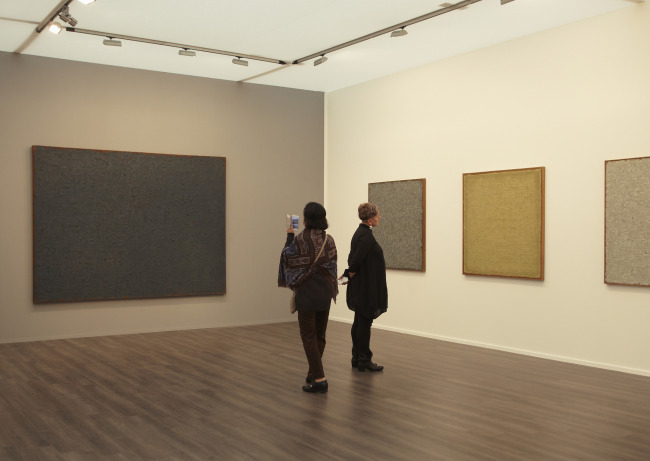LONDON ― Visitors are greeted by a variety of compelling contemporary artworks that defy the perception of an art fair as an art sales venue. Intriguing performances are held throughout the annual Frieze Art Fair that brings some 160 leading contemporary galleries from around the world to Regent’s Park, London.
With the influx of high-spending collectors, Frieze London is also one of the most successful art fairs in the world, and its sales have been increasing.
Damien Hirst’s 1993 fish cabinet sculpture “Where Will It End” was sold for 4 million pounds ($6.3 million) at White Cube Gallery just 10 minutes after the four-day fair opened to VIP guests on Tuesday, a day before the official opening.
 |
Visitors view artworks by Korean artists at Frieze Art Fair. (Frieze Art Fair) |
The London event mainly focuses on European collectors and European galleries. But the world’s hottest contemporary art fair also featured a handful of Asian galleries from China, Japan and South Korea to introduce Asian artists.
Kukje Gallery, one of South Korea’s top galleries, presented several Korean artists, including Ham Kyung-ah and Yang Haegue, whose works have recently been recognized at art museums around the world.
“Museums and curators have expressed interest in the works of the two artists,” said a gallery sales staff.
Ham’s embroidery paintings made with the help of North Korean workers were among the first to be sold at Kukje Gallery.
Yang’s “Sonic Fabric” series installations of nickel plated bells, light bulbs and cables blended in well with other cutting-edge installations and sculptures at the art fair. Another of Yang’s metal bell installations was featured in Galerie Chantal Crousel, a major French gallery in Paris.
Korean modern painters are being extensively shown in the Frieze Masters, an event that features ancient and modern art.
With a wide range of artworks, from the first century “Torso of Aphrodite” to paintings by old masters such as Rembrandt and Rubens, the Frieze Masters drew in top collectors from around the world.
Alongside the old Western masters, Korean painting masters from the 1960s to the 1980s are being introduced to international buyers. They are Ha Chong-hyun, Lee U-fan, Kwon Young-woo and Chung Sung-hwa ― key figures in the Korean Dansaekhwa movement.
Los Angeles-based Blum & Poe Gallery dedicated an entire booth to Dansaekhwa paintings ― Korean monochrome paintings from the 1960s to the 1980s.
“The paintings bring people in because they have an appearance of being calm and quiet ― quite opposite to the crowded art fair,” said Timothy Blum, cohead of Blum & Poe Gallery. The gallery is running a Dansaekhwa exhibition in L.A.
Those paintings priced between $45,000 and $400,000, among others, have been successful in catching attention from Western collectors. Ten of the paintings on display were sold on the first day of the fair.
Kukje Gallery focused on paintings by Ha Chong-hyun, one of the few living Dansaekhwa artists.
 |
Visitors view Dansaekhwa paintings by artist Ha Chong-hyun at the Frieze Masters. (Frieze Art Fair) |
“It’s great that two galleries are presenting Dansaekhwa paintings. If it was just one gallery showing the paintings, people would have thought it’s just a sales strategy. But two galleries focusing on Dansaekhwa paintings proves that it is a notable movement in art history. Dansaekhwa painting are works not for entry-level collectors, but for seasoned collectors who understand paintings very well,” said Joan Kee, art history professor of the University of Michigan-Ann Arbor and author of “Contemporary Korean Art: Tansaekhwa and the Urgency of Method.”
Another Dansaekhwa exhibition is coming up next year. Park Seo-bo, well-known for sketching Dansaekwa with pencils, plans to hold an exhibition at Galerie Perrotin in Paris in 2015.
Uli Sigg, one of the most influential collectors of contemporary art, said he wanted to see diverse works at the Frieze Art Fair, including more Asian works.
“I would like to see more Asian galleries than they have at the Frieze this year. The selection process of artworks at this fair is mainly done by Western people. They select what they know. And I hope the art fair may add a slow change. But the real change will come when more Asian people are here. For the maturity of the fair, there should be more Asian people,” said Sigg, former Swiss ambassador to China and a media executive.
By Lee Woo-young (
wylee@heraldcorp.com)







![[Today’s K-pop] Blackpink’s Jennie, Lisa invited to Coachella as solo acts](http://res.heraldm.com/phpwas/restmb_idxmake.php?idx=644&simg=/content/image/2024/11/21/20241121050099_0.jpg)

